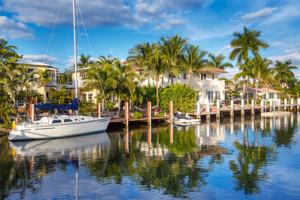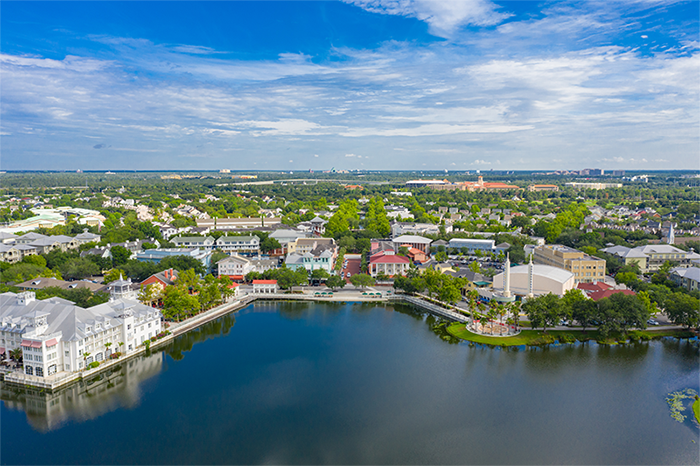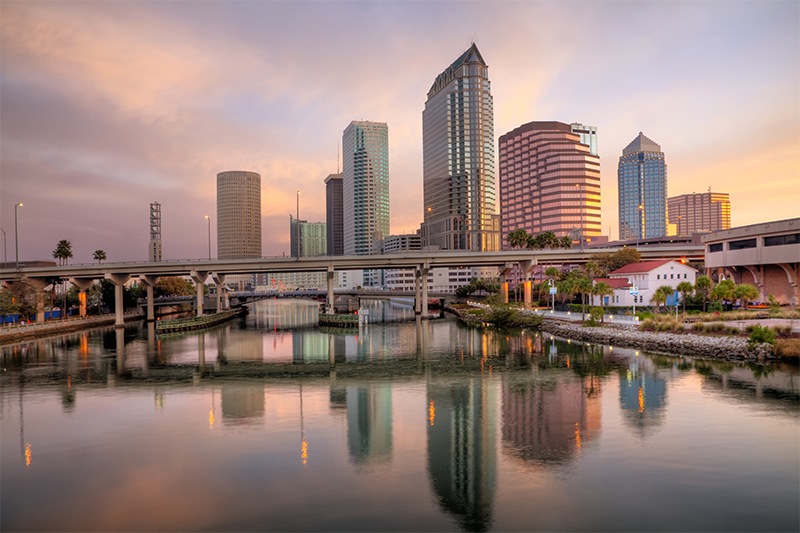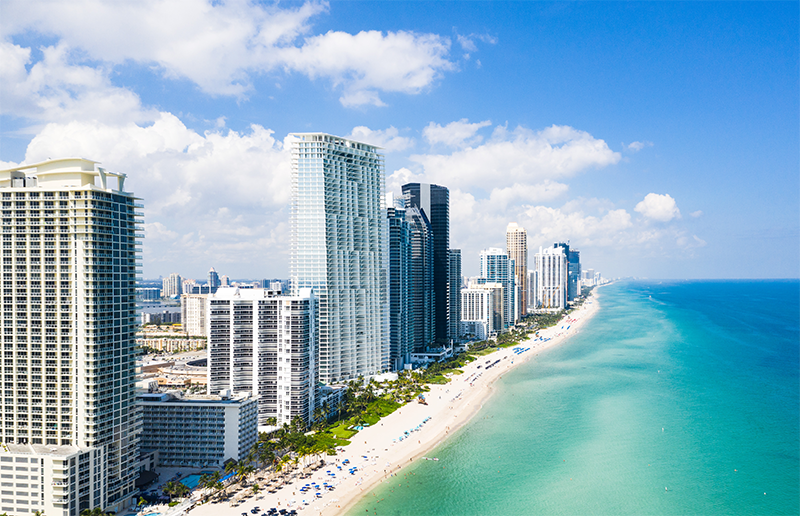Sharestates’ Florida Regional Sales Director Scott Evans moved from New York to Celebration, Florida to work remotely. He’s not the only one. In fact, Florida is now the third most populous state in the U.S. thanks to the remote work trend and huge population growth in recent years.
Between April 2020 and April 2021, almost 330,000 people relocated to Florida. From 2010 to 2020, Florida experienced a population growth of 14.6 percent, an increase of 2.7 million residents.
The impact this has had on Florida’s real estate prices can’t be overstated. It all boils down to three little words: Supply and demand.
 Low Housing Inventory Creates Opportunities for Investors
Low Housing Inventory Creates Opportunities for Investors
Like the rest of the country, the Florida real estate market is hot right now primarily due to a lack of inventory. “This is as hot as I’ve ever seen a market,” Evans said.
But it’s not just lack of inventory that is driving the market. It’s also rising real estate prices, cash buyers stepping in and swooping up houses on the market in a matter of days, and international buyers adding pressure on top of pressure. In the Orlando area, Evans said there are hardly any rentals so it’s difficult for middle- and low-income earners to find a place to live. But Evans said he’s not sure how long it will be sustainable.
Even if there’s a correction, which he expects to happen within a few months, savvy real estate investors will have golden opportunities. And Sharestates will be there to help those investors structure their deals.
Regular home buyers will struggle as prices continue to rise and ground-up development continues to fall behind the pace of population growth, Evans said. Investors, on the other hand, can profit from market opportunities if they can spot them fast enough.
The same market conditions prevalent in Orlando can be seen in other major cities in Florida. Whether Tampa, Miami, West Palm Beach, Fort Lauderdale, or Jacksonville, the story is the same. Prices are going up and there’s not enough housing to meet demand. Smaller cities like Ocala, where there’s plenty of raw land, are growing as ground-up construction adds new homes to the market, but developers can’t build fast enough. In the larger cities like Orlando and Tampa, multifamily development is stronger.
The biggest sprawl taking place right now is between Orlando and Tampa along the I-4 corridor. Polk County is the bridge between these two cities and Lakeland is the largest city along the corridor with a population of around 100,000. The Lakeland metro area is seven times bigger. With lots of land to build on, developers are going hog wild.
The Hottest Real Estate Markets in the U.S. Are in Florida
According to Zillow, Tampa is the hottest market in the nation. The reasons are simple:
- Rising real estate prices coupled with historically low mortgage interest rates
- High demand for housing with low inventory
- A thriving job market
- Population growth
- Remote-work feeding that growth
- Demand driven by Baby Boomers and Millennials looking for the best place to live
The same factors are driving the Florida real estate market in other Florida cities and both Jacksonville (No. 2) and Orlando (No. 9) made Zillow’s top 10 hottest markets for this year.
Evans points to Tampa’s revitalization efforts in the last decade as the primary driver of that city’s real estate environment. The waterfront has been rebuilt, many buildings have been rehabilitated, and multifamily residential units have blossomed. Plus, the job market. “It has the perfect balance of supply and demand,” he said.
People like the climate in Florida, but Evans said it’s also the cost of living. Florida has no income tax and it’s less expensive to live there than in other states, especially New England states.
Where Florida Fix-and-Flips, Rentals, and Ground-Up Development Are Hot
“There is still plenty of fix-and-flip and rental opportunities, single-family, and multifamily, in Southeast Florida,” Evans said. “From West Palm Beach down to Miami, there are older structures that have been there for 70 or 80 years that need rehabilitation.”
Evans sees those deals come across his desk every day.
While fix-and-flips and single-family rentals are hot in the region, there’s not a lot of room for ground-up construction. Refinancing properties is a big deal in that area. The volume of real estate opportunities in the southeast region of the state makes it the perfect place for fix-and-flip investors and rental property owners.
Other areas of the state, such as Orlando, Tampa, Naples, and Jacksonville have rental property opportunities, but Evans said Southeast Florida is still the best place to be for rentals. As noted before, the I-4 corridor is the best place for ground-up development.
“Ocala is an up-and-coming area for rentals,” Evans said. Still, head southeast.
Will the Florida Real Estate Market Crash?
One question that has been asked a little more often in recent months is whether the current real estate market can be defined as a bubble. Evidently, home buyers think so. Experts don’t.
“Investing has changed in the past two months,” Evans said. He attributes that to interest rate increases, which are slowing down refinances. The Fed recently raised interest rates by a quarter-point and plans to do it again six more times in 2022. That’s certainly going to have an impact on refinancing. It will also likely impact borrowing and lending for real estate deals. But cash is still king.
Evans believes ground-up construction will continue to thrive. Certain fix-and-flip markets will also continue to do well, he said. He doesn’t see housing demand declining by too much.
“About 75 to 80 percent of the deals we get are on rentals and refinances,” Evans said. “But in the last six weeks, about 90 percent of them have been bridge loans on new construction projects, rehabs, and fix-and-flips. I see that as where the investing market is headed in the short-term.”
Long-term, Evans sees a market correction.
“It has to happen,” he said. “Current market conditions aren’t sustainable.”
However, whether real estate prices suffer or the bottom falls out will depend on each market. Some will get hit harder than others, he said.
“It’s a perfect storm of rising interest rates, home values, wages not going up fast enough to keep up with inflation, low inventory, and some other factors,” Evans said.
In Orlando, service industry wages are around $15 an hour. With an income of $25,000 to $30,000 a year, many people can’t afford to buy homes. In a market where home prices are high and getting higher, and rents going up too, an economic downturn could stabilize the market, he said.
When the correction comes, Evans said, Orlando probably won’t be affected too much. Ocala, on the other hand, will likely get hurt. There’s a lot of investing activity going on in this small town with a population of less than 100,000. The Fed’s interest rate hikes, however, will likely impact the real estate market with a gradual easing so it will lessen the pain for those markets that take a harder hit.
In terms of home prices, it’s all about supply and demand. In Celebration, for instance, a home that went for $450,000-$500,000 two years ago will sell for $800,000 to $1 million today. That’s evidence of the high demand for housing in the town that Disney built. In other communities, prices aren’t going up as fast.
These factors currently driving the market will likely be less influential when the correction comes. Still, investment opportunities will be available even then.
Evans’ Advice for Real Estate Investors in Florida
The biggest challenge for investors in Florida is finding deals. Finding undervalued properties is hard because there is so much competition, not enough inventory, and prices rising fast. It’s happening in every market in the state.
For that reason, investors need to be very familiar with the neighborhoods they’re working. He said investors should exercise caution and not be too aggressive.
“Be patient and keep your ear to the ground for undervalued properties,” he said. “Don’t go for the higher-priced properties because the market could turn.”
Where can investors find those undervalued properties? A good place to look is in second-tier cities where the middle class lives. Towns like Ocala, Cape Coral, and Gainesville. Sellers are still selling at peak prices, and there’s a lot of ground-up development, but there are still some fix-and-flip opportunities in the mid-market range. It’s easier to profit on a $300,000 investment than a $1 million investment, he said.
The one thing that will have the biggest impact on the Florida real estate market is whether the state’s population growth continues at the pace it has for the last decade. More people moving to the state with a low inventory of housing is going to keep prices high. It will also mean any recession or market correction that does come won’t impact Florida as much as it will other areas of the country. Overall, Evans is optimistic about the short-term and long-term real estate market in Florida.
When you need a loan, call Scott Evans.





